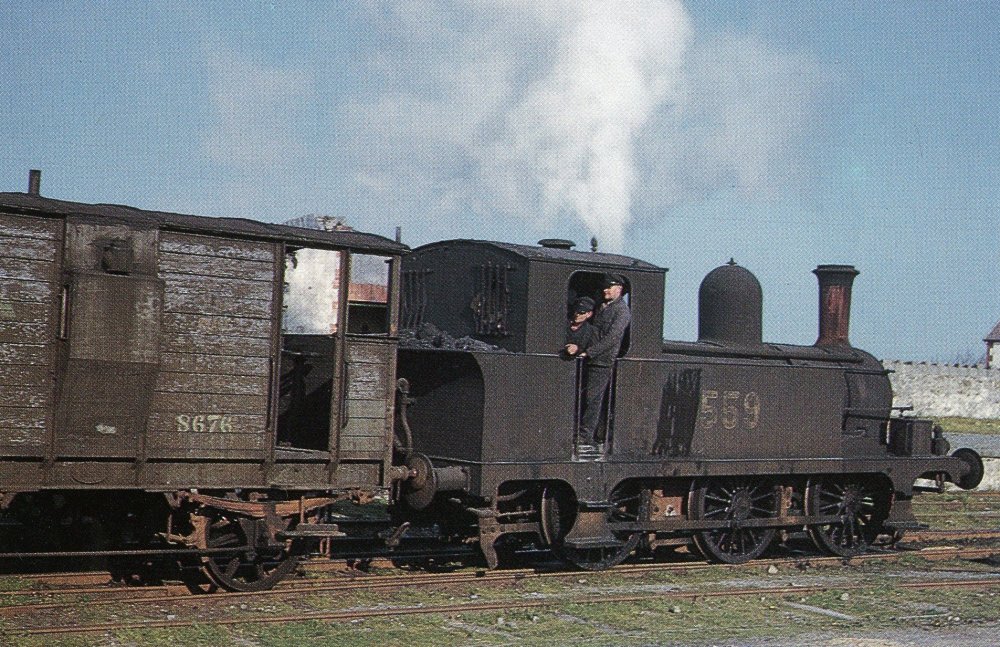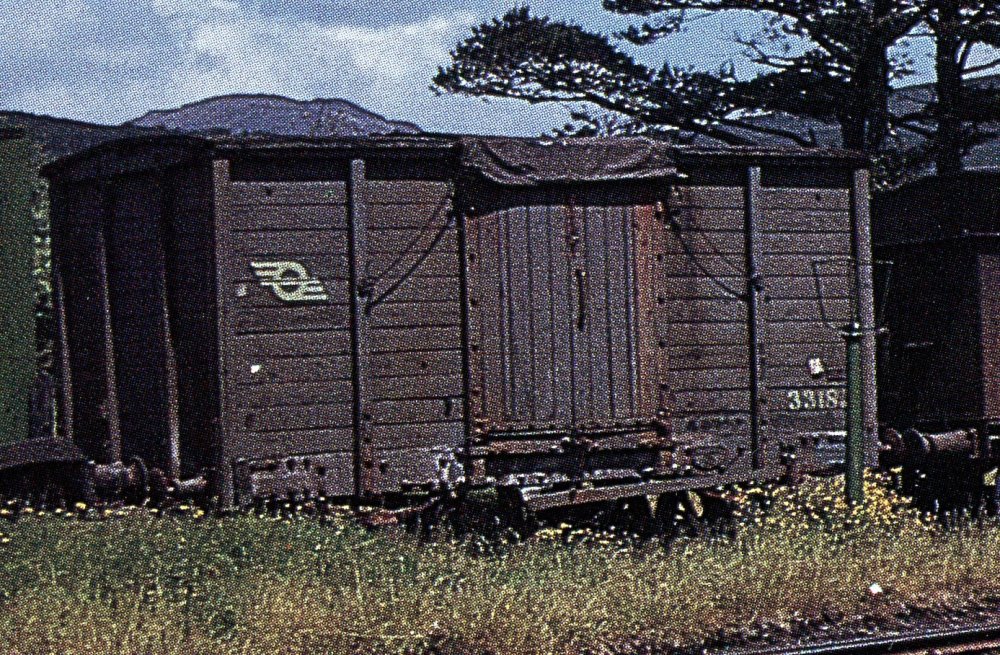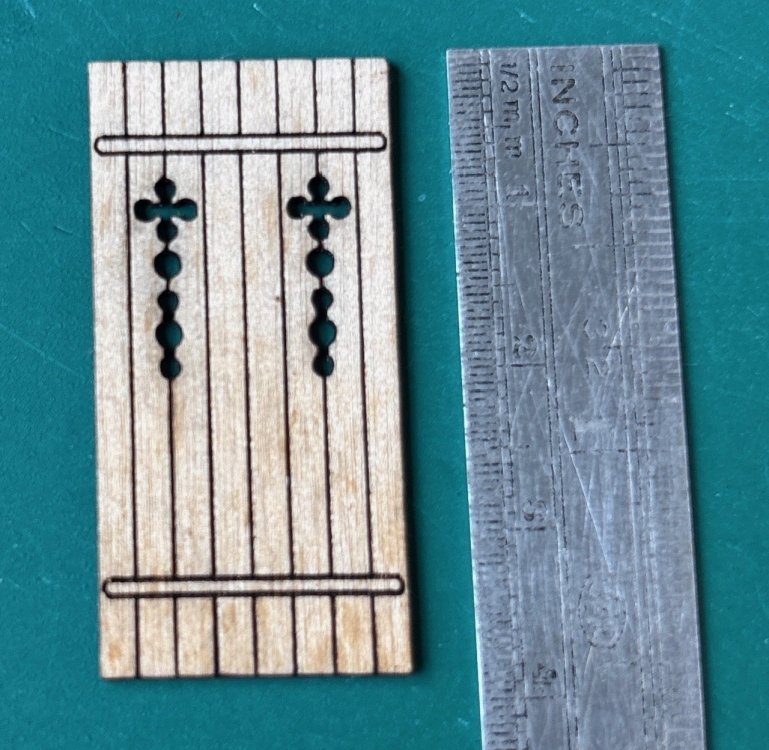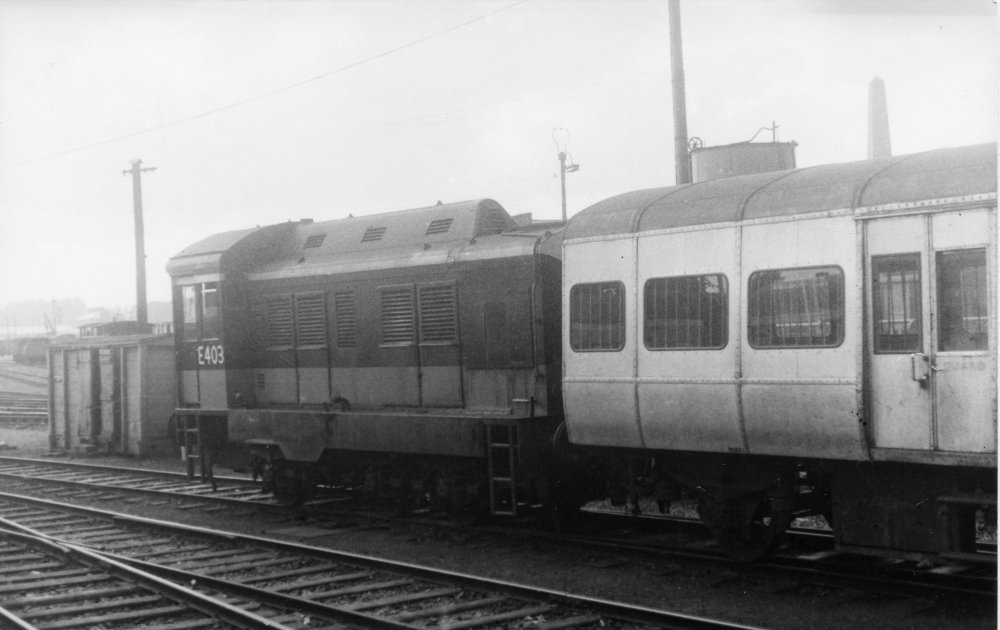
Mol_PMB
Members-
Posts
2,159 -
Joined
-
Last visited
-
Days Won
112
Content Type
Profiles
Forums
Events
Gallery
Blogs
Store
Community Map
Everything posted by Mol_PMB
-
In the early 1920s, the Irish Railway Clearing House (IRCH) published drawings for 'standard' designs of goods vans and high-sided open wagons, which henceforth would be the preferred designs used by many Irish railways. The designs were published in 1924, but had been under development for some years. Whilst this move was broadly contemporary with the British RCH revision of wagon designs in 1923, the Irish designs were quite different in dimensions, constructional details and appearance. They appear to have been based on what was considered 'best practice' by the Irish railways at the time, rather than to import design features from GB. Hardly surprising given the political atmosphere of those years! However, there was provision to use GB standard components where these might be more economic than non-standard parts. A couple of years ago, @jhb171achill was kind enough to post the IRCH drawings as published in 1924, and these are immensely helpful: A fair number of wagons had been built broadly to these designs as early as 1920, possibly earlier, and then formed the basis of the IRCH design recommendations. So we do find IRCH-type wagons built by or for the GSR constituents. The IRCH designs covered 4 main wagon types: Goods van, wooden framed Goods van, steel framed Open wagon, wooden framed Open wagon, steel framed The underframe designs could also be used for a wider range of wagon types if required. Over time, variants of these designs evolved to suit particular needs. In this thread I am going to illustrate the wooden framed goods vans. These were based on an earlier GNR design, and were built by (or for) the GNR, GSR and MGWR, with several variants. Some remained in use into the 1970s and were painted in CIE red-brown livery. As far as I can tell, this design was not used by the other Irish companies - the GSWR and later CIE preferred the steel-framed van design and the DSER, BCDR, NCC etc went their own way. This photo by Brian Flannigan on Flickr is a superb clear illustration of the standard design, in this case a GSR-built van: Key spotting features of the design include: Wooden underframe, 9'6" wheelbase, W irons and oil axleboxes with tall rectangular covers Horizontally planked body, the same outside width as the solebars Vertically planked doors, with reinforcing strips top and bottom Vertical wooden stanchions The outer side panels are broader than the inner side panels Basic size and shape are the same as the H van (on the left) Jackdaws perched on the roof are non-mandatory Leslie has produced a kit of the GNR variant of this design, although I'm not sure whether these are still available. more to follow...
-
"Voiding the Warranty" - Mol's experiments in 21mm gauge
Mol_PMB replied to Mol_PMB's topic in Irish Models
E407 starting to look the part, but still plenty of detailing to do! I must remember that I need to order another set of motor, gears and wheels too.- 319 replies
-
- 11
-

-

-
Old Goods Wagons with Center Roof Canvas?
Mol_PMB replied to Auto-Train Original's topic in Irish Models
Indeed. It was particularly the IRCH design with the flatter roof that I had been searching for. There can't have been many of them - they're much harder to find than green H vans or GSR grain hoppers for example (though perhaps slightly less obvious in photos too). I fancy modelling several of these IRCH wooden-framed vans with detail differences - a GNR vac fitted variant, an MGWR convertible, a normal GSR van, and a double-skinned GSR van. -
Summer Diesel Day at Downpatrick Saturday 23rd August 2025
Mol_PMB replied to Niles's topic in What's On?
This time, I have decided to sail on the Birkenhead - Belfast service, and stay in Belfast. I'll be arriving Friday morning and leaving Monday morning, so hopefully time for one day at Cultra, one at Whitehead, and one at Downpatrick, plus a bit of train travel. No 111+Gatwicks or 80 class to enjoy these days, but Grand Central and the 4000s will be new for me. -
There are plenty of photos of ex-MGWR 0-6-0T 560 at Fenit, mainly because it hauled a railtour there, full of gricers with cameras. There are also a good number of photos of 560 at Tralee, shunting wagons, and 560 is mentioned as the regular steam loco on the Fenit branch in the late 1950s and early 1960s. I'd found no mention of other members of the class. Whilst trawling my books for wagon photos, I've just stumbled across this photo of 559 at Fenit in 1960, along with a rather nice old brake van. While 560 was modified for the W&T with an enlarged cab and narrower footsteps, 559 retained its original cab and footsteps: The photo appears in 'Irish Railways in Colour - a second glance' (Ferris) and is credited to Des Fitzgerald.
-
Old Goods Wagons with Center Roof Canvas?
Mol_PMB replied to Auto-Train Original's topic in Irish Models
This snippet intrigued me, and I have been looking out for them whilst trawling through photos online and in books. I've finally found one - in 'Irish Railways in Colour - a second glance. On page 38, credited to the Midland Publishing Colection, and dated 1958, here is 3318M, an IRCH 'convertible' van: It's in early CIE dark grey livery with eau-de-nil snail and numbering. The ropes are tied to special eyes on the uprights, which are absent on the equivalent vans with full roofs. For comparison, here's another similar MGWR van 3259M with a full roof: https://www.flickr.com/photos/irishrailwayarchive/53511621949 This normal full-roofed variant of the IRCH wooden-framed goods van was used by the GNR, GSR and MGWR. The GSWR preferred the steel-frame version, which was also adopted by CIE prior to the H vans, but I've found no evidence of other railways adopting the IRCH van designs. -
Some serious discounts there - including on Accurascale 88DS and Dapol 08's. Anyone fancy trying a 7mm scale D class conversion? Anyone looking for a J15? https://www.ebay.co.uk/itm/135866574295
-
Super - some excellent viewpoints there that really capture the atmosphere of the layout. Great work by both modeller and photographer!
-
Summer Diesel Day at Downpatrick Saturday 23rd August 2025
Mol_PMB replied to Niles's topic in What's On?
I still have to commute on the 150s - their underfloor-engined equivalents. I'm afraid I can't get dewy-eyed over 450s (or 150s), but at least they were better than Pacers. The diesel locos are of much more interest, as are the other exhibits and rolling stock. I've never been to Downpatrick before. It looks like there's a reasonable bus service from Belfast? -
Many thanks, both. For completeness I should also mention Martin Bairstow's 'Railways in Ireland - Part Four - Great Southern & Western' which gives a brief route-by-route history of the lines geographically within the GSWR region. Most photos are from more recent eras (GSR, CIE, and modern ones). It's strongly geographical with very little about the history of the company itself. Not a bad book, but nothing about rolling stock. I have found a secondhand copy of the GSWR locos book at a good price, so I've ordered that to fill another inch in my Irish railway bookshelves!
-
Summer Diesel Day at Downpatrick Saturday 23rd August 2025
Mol_PMB replied to Niles's topic in What's On?
Excellent. I’ve booked a long weekend in Belfast to coincide with that date. Hopefully I can get to Whitehead and Cultra too, and see the new Grand Central. -
For info, my understanding of the numbering scheme is as follows: Carriages: 1st class: 1140 onwards 3rd class: 1290 onwards (eventually reaching 1558 with the Cravens) Brake 3rd: 1890 onwards (eventually reaching 1946 with the Park Royal conversions) Composite: 2090 onwards Catering: 2400 onwards Full brake: 2540 onwards This scheme continued into CIE days for all the steam-heated stock, with new categories added for railcars, steam heat vans etc. The use of the next-available 2600 series for the 1950s AEC railcars was reprised by the Arrows in the 1990s, and of course forms the basis of the railcar fleet numbering today. Wagons: High-sided opens: 10000 onwards (though there are also some in the 9000s, I'm not sure whether the block started at 9000 or whether those were the last of the old consecutive numbering scheme) - this series was almost filled up by the final corrugated opens. Goods vans: 15000 onwards (eventually reaching 19754 with the H vans, and then jumping ahead to a new 26000 series for the Palvans) Cattle vans: 20000 onwards (these reached 21617) Flat wagons: 23000 onwards Brake vans: 23500 onwards (these reached 23694 with the 30T vans) Special wagons: 23700 onwards Ballast and PW wagons: 24000 onwards (the series is subdivided into various blocks; the last one seems to be the 1978-built plough brake 24854) This scheme continued into CIE days and many new categories were added. Things did get a bit mixed up in the 1970s but order was restored for the CIE bogie wagons numbered in blocks in the 30000 series, some of which are still running today.
-
This layout is superb, as is the rolling stock! Both the atmosphere and the attention to detail. I almost wish I'd re-started my Irish modelling in 7mm scale, but it's too late now.
-
Even if it's not a simple bribe, his cronies playing the money markets (probably with a strong hint of what's about to happen) will be making a fortune.
-
I think I can narrow down the range a bit, though I am making an assumption that the numbering policy for wagons changed at the same date as the policy for carriages. Wagons supplied by Hurst Nelson in 1907 were in the old numbering scheme. Bogie carriages built by the GSWR in 1915 were the first carriages built in the new numbering scheme. The new numbering scheme for wagons was definitely in use by 1920 but the numbers reached indicate that it had started a few years earlier. It occurs to me that there was also a change in loco numbering policy around the same time, with the new classes starting at 400, 500, 900. Maybe Watson influence?
-
At some stage in the 1900 to 1920 period, the GSWR introduced a new numbering scheme whereby blocks of numbers were allocated to particular wagon or carriage types. For example, 15000-19999 was allocated to goods vans. This number scheme was continued by the GSR and CIE for both wagons and carriages, and (with some developments) is still with us today. What year was it introduced?
-
"Voiding the Warranty" - Mol's experiments in 21mm gauge
Mol_PMB replied to Mol_PMB's topic in Irish Models
Reasonable progress so far on my bank holiday weekend project: I've decided that this will be E407 in black livery, suiting the 1964-1974 period. This photo by David Heath on Flickr shows it in 1964 when the black livery was still fairly fresh: -
Indeed, or for those wanting liveries not in the forthcoming batch. I'm interested in the grey ones if no-one else wants them, but because I'm in the UK I appreciate that may be a hassle so I'll hold back for now.
-
Can anyone recommend good books on the GSWR and/or the GSR, either general histories or with a focus on rolling stock? At present I'm trying to piece together the details of the 5'3" gauge wagons inherited by CIE. I've made a lot of progress based on photos, and there is some detailed info in books on the smaller GSR constituents (e.g. CB&CSR, MGWR, WL&WR) Most of the smaller Irish railways seem to have their own dedicated books, sometimes two or three titles on the same obscure branch line. But I've struggled to find much on the GSWR and GSR - am I missing something? I do have 'The Great Southern and Western Railway' by K.A.Murray and D.B.McNeill, published about 50 years ago. For its time, it's good, but with only 200 small pages and 50 pictures (most of which are formal loco portraits) it's nothing like as detailed as more recent works on other lines. There is only one page of text on goods wagons and not much more on carriages, and not even an overview of the quantities of rolling stock. I also have 'Great Southern Railways' by Donal Murray, a useful picture album but not attempting to provide a formal history or any details or statistics on rolling stock. 'Irish Broad Gauge Coaching Stock' by Des Coakham, with such a broad subject cannot cover any railway in great detail and the GSWR and GSR sections can only provide a brief overview and a few examples which tend to focus more on the oddballs than the typical. I am aware of two large tomes focusing on locomotives: 'Locomotives Of The Great Southern & Western Railway' by Jeremy Clements, Michael McMahon, Alan O'Rourke; and Locomotives Of The GSR' by Jeremy Clements, Michael McMahon. I don't have these, and my interest isn't really in the locomotives, though I might consider buying them to peer into the background of photos looking for more interesting things like wagons and carriages. Does anyone on the forum have these? Would you recommend them? In the IRRS journals, there's a very useful article 'GSR Coaching Stock, 1924-44' by B Pender, but I haven't found much on the GSWR, or much info on wagons of either company. Is there anything else that I should look to add to my library? Many thanks, Mol
-
It would do a nice job of engraving the surface patterns and cutting out the strips too. Could be done in a material like 1.5mm or 2mm MDF to match the thickness of the real coping stones. Here's a little test piece I just found lying around - an elaborate window shutter (this is in 7mm scale) cut and engraved on 1.2mm ply: And a whole building I designed and made using the laser cutter: I haven't unleashed the laser cutter on an Irish project yet, perhaps I should!
- 112 replies
-
- 11
-

-

-

-

-
Interesting! On a similar theme, Alcock and Brown landed* at a rail-served 'airfield'* when they arrived in Ireland, and famously travelled on another Irish industrial railway to reach the nearby town of Clifden. * It was more of a crash in a bog, but still...
-
The one on the left is an ex-GNR vac fitted van. The GNR van design evolved over the years with increased tonnage capacity and size, and only a small proportion were vac fitted. The later 1920s design was published as an Irish RCH standard, and they were also produced for the MGWR and GSWR/GSR with some variations. I have been collating data on these and maybe I should start a dedicated thread. Leslie used to make a kit for the GNR ones but I'm not sure wheher these are still available. The GNR used the Briitsh Railways painting approach for its wagons: grey = unfitted and red-brown = fitted. Hence the appearance of a red-brown van pre-1970. Different to CIE where everything was grey, and later everything was brown, regardless of brakes. A couple more pics of the vac-fitted later version from Ernie - I have collated many more... And from Brian Flannigan on Flickr, a GSR version (unfitted):
-
Here are some of Ernie's photos on Flickr showing 'normal' (not green) fitted H vans, with just plain 3-link couplings, not even an instanter. On the other hand, this one has instanter couplings. And of course the green ones had screw couplings. Seems like there were plenty of variations!
-
"Voiding the Warranty" - Mol's experiments in 21mm gauge
Mol_PMB replied to Mol_PMB's topic in Irish Models
I think the tweaks needed would all be easy in CAD as you suggest. Check the wheelbase. One of my books lists these as 10' wheelbase though their predecessors were 9'6". Your existing model definitely has a shorter wheelbase than the ones in the photo above. A subtle point - on this late batch, on the solebars there aren't any washer plates for the bolts. I think you should also reduce the 6 planks to 4 and a half wider ones (same overall height, just move the plank lines). There are some other photos of wagons from this batch in the IRRS archives and they also seem to have fewer, wider planks, so it was probably standard for the batch. As well as being prototypical, that would make them visually a bit more different. The position of the half-plank seems to vary! https://www.flickr.com/photos/irishrailwayarchive/53570935855 https://www.flickr.com/photos/irishrailwayarchive/54419501956 https://www.flickr.com/photos/irishrailwayarchive/54419695864 https://www.flickr.com/photos/irishrailwayarchive/54419501966 I was able to modify/update the axleboxes on the two I've built already, but it would be good to have the IRCH standard design ready-made and this would suit many other wagon types. -
I'm still trawling Flickr for green tin van illustrations, there will be a follow-up post here in due course. But I have come across another unusual variation that I just thought I'd show here. This photo is from Brian Flannigan on Flickr, and it shows tin luggage van 2737 in black and tan livery. The unusual bit is the horizontal beading along the waist, which is not normally present on a tin van. Now, I knew I'd seen this once before, and here's that other photo, which is a print I bought on eBay mainly for the E class it features. We can't see the number on this silver tin van; it also has a horizontal bead but it's a few inches lower down than on 2737. My best guess at the moment is that this was associated with a collision repair, and probably only on one side of the vehicles. But I'd be open to correction if anyone knows more! Just as a reminder of what normal ones looks like, here's a photo from Ernie on Flickr: Also available in green, to stick with the thread theme:
.png.c363cdf5c3fb7955cd92a55eb6dbbae0.png)







